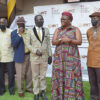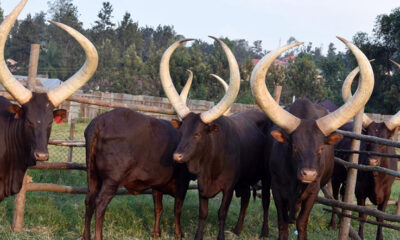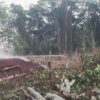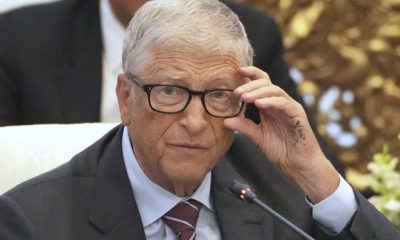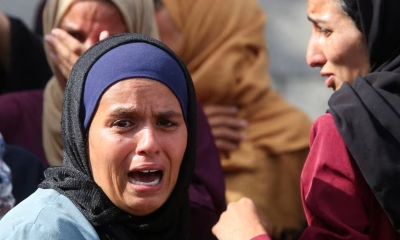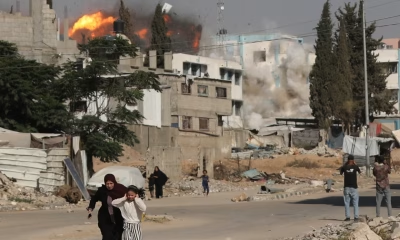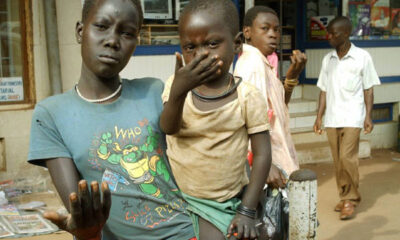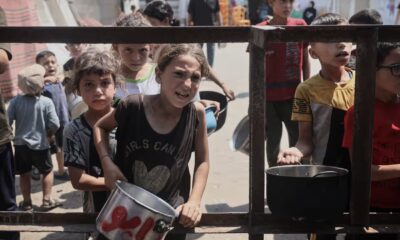Editor
Nuwa Wamala Nnyanzi’s life story and contribution to arts development
Belief in God, Professionalism and a shared destiny have guided him to success
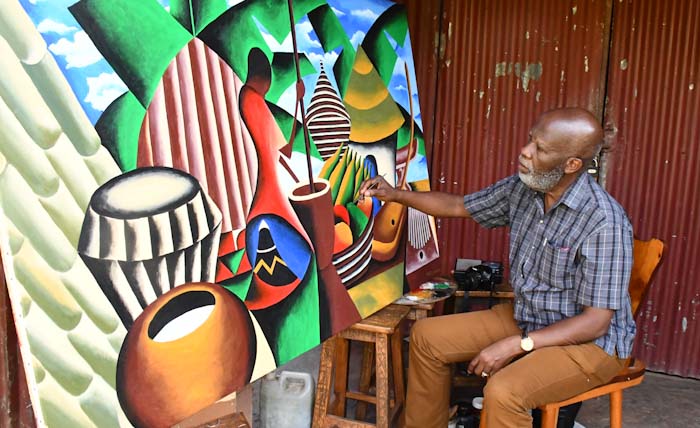
Nuwa Wamala Nnyanzi at work outside his Nnyanzi Art Studio at the National Theatre Crafts Village in Kampala
Nuwa Wamala Nnyanzi is in the eyes of many, Uganda’s most successful visual artist. But Nnyanzi is actually many things to many people. He is a staunch Christian who believes in the power of Christ as the supreme guide in his life. He is also avowed monarchist and traditionalist who believes that God intended to have the diverse races and nationalities. As a result, he pays equal respect to the traditions and cultures of Buganda and Bunyoro to which his father the late Henry Wilberforce Wamala and mother Erina Bachayaya Atwooki (rip) belonged, respectively.
Nnyanzi is also a leader whose desire to shape a better world has pushed him to share his talents, knowledge and skills with as many people as possible. He has consequently served in different public roles including as a Minister for Internal Affairs in Kabaka Ronald Muwenda Mutebi’s government, patron and active promoter of many artistic groups. He has been a consultant on innumerable panels aimed at lifting the status of art, culture and the tourism industry as a whole.
His journey from the army into exile and then into art, is a tale of a victim of circumstances.
In June 1977, Nnyanzi recalls that he was thrown into a military prison in Makindye, on charges of conniving with thieves to steal medical supplies meant for soldiers. He denied any wrong doing, and instead blamed the makeshift, weak structures in which the medicines were being kept, had made it easy for the thugs to break-in without his assistance.
“But many people who knew me, realised I was being framed and worked to organise my release.”
After nine days he was indeed out of prison and in a hideout in Masindi and later on Jinja. He stayed there for about a year before the army launched a mission to rearrest him. He knew of the plot early enough and beat it by proceeding to Nairobi Kenya, where he stayed with his cousins starting with Rose and her husband Moses Wasonga and later on with Dorothy and her husband Jones Kiwanuka.
Despite his familiarity with Nairobi where he had been as a student of computer course in keypunch operating before joining the army in early 1972, Nnyanzi, wanted to lead an an informal life of a refugee.
Armed with a talent and passion for painting, Nnyanzi considered art as his default job that would help to sustain him in a foreign land and wean him off dependance from his cousin Dorothy Namatovu and his in-law Jones Kiwanuka who had offered to give him refuge. All the arrangements to stay with my cousins had been made possible by his aunt Maama Ezeresi Kawoya.
Tracing his beginnings, Nnyanzi says: “I had no job, but I had the talent. Jones gave me 20 Kenyan Shillings to buy art materials. I used it to buy the stuff I would use, after I came into contact with Dan Sekanwagi a Ugandan artist who advised me how to go about the industry. As we went about discussing my ideas, he told me that the type of art that was selling at the time, was Batik.”
“I asked him, how it was done. He told me he didn’t know. And the established artists were not willing to teach upcoming ones. What we did was to look for books, visit curio shops and spent sleepless nights reading as we practiced.
One day, Nnyanzi’s aunt Maama Kawoya, linked him to Rev. Kefa Ssempangi, who would later serve as a deputy minister in Dr. Obote’s second government, whose philanthropic Africa Foundation organisation was helping dozens of refugees with donor support from the United States and The Netherlands.
Nnyanzi recalls: “When I talked to Rev. Dr. Ssempangi, he challenged me to do a batik piece of a map of Africa. I didn’t hesitate. When I finished the job, he sent me 350 Kenyan shillings. This was a windfall at the time because we used to sell our batik pieces at 5/=. This greatly inspired me to concentrate on this business. I realised there was money to be made in art.” Rev Dr Kefa Sempangi is an accomplished fine artist with a PhD.
“From then on, I didn’t look back,” he recalls. It didn’t take long before he could put together a solo exhibition, at the Goethe Institut Nairobi – the Germany cultural and language centre in Nairobi.
With the help of personal connections, including a step sister Florence Ouma, (Rip) who had a well paying job with HABITAT – a UN organisation for improving housing conditions for humanity, Nnyanzi didn’t struggle to find buyers of his batik pieces.
A decent education by his parents came up to the level of Senior Four, and strict upbringing by his parents, both of whom were health professionals, empowered him with life skills, let alone the ability to express himself in English.
Having established his niche as a batik artist, his connections helped to bring him into contact with influential diplomats who not only appreciated the medium of communication, but also had the money to spend.
He recalls: “My sister bought two of my pieces and hang them in her apartment. Whoever would see them, she would tell them, my brother is the one who does it. She did a great deal of marketing for me. She also brought me into contact with the expatriate community who patronised my art. Every Friday, they would work half day, and I would go there to collect money from the pieces I had done.”
One friend led to another, and before he knew it, he was rubbing shoulders and sharing luncheons with representative of international bodies such as the UN children’s body UNICEF, Family Planning International Assistance, etcetera.
“One day, a friend Chantal Bunyenyezi, introduced me to Nancy P Harris, her boss who was the Executive Director of Family Planning International Assistance (FPIA). She asked me to do a piece for a guest who was coming from New York. On the day of presenting the prize they asked me to be part of the luncheon at which they presented the gift, and they asked me to make comments, at the end of the function.”
Noticing the interest of the visitors, Nnyanzi, suggested that perhaps, they could support the holding of an exhibition themed around family planning, to which they agreed.
A bit of luck played in his favour because the Kenyan government was in final stages of unveiling its first-ever family planning campaign.
“I put together 30 pieces exclusively focusing on family planning in October 1984, just two months after President Daniel Arap Moi had launched the country’s family planning campaign. Many people thought I was responding to the President’s address. But this was just a coincidence,” recalls Nnyanzi.
The exhibition on a subject as novel and controversial as family planning at the time, brought him immense exposure to the international community.
“The exhibition was covered by several national and international media channels including BBC, Christian Science Monitor, People magazine and Viva magazine. I became the face of family planning at the time.”
These initial lucrative jobs and contacts opened more doors for Nnyanzi. Before long, he was landing invitations to international exhibitions and contracts.
In 1985, I was invited to participate in an international exhibition in Seattle -Washington. Thanks to my profile, I didn’t find any huddles in securing a Visa to the United States.
Now aged 68, it is almost impossible to name a regular international art exhibition that Nnyanzi has not participated in.
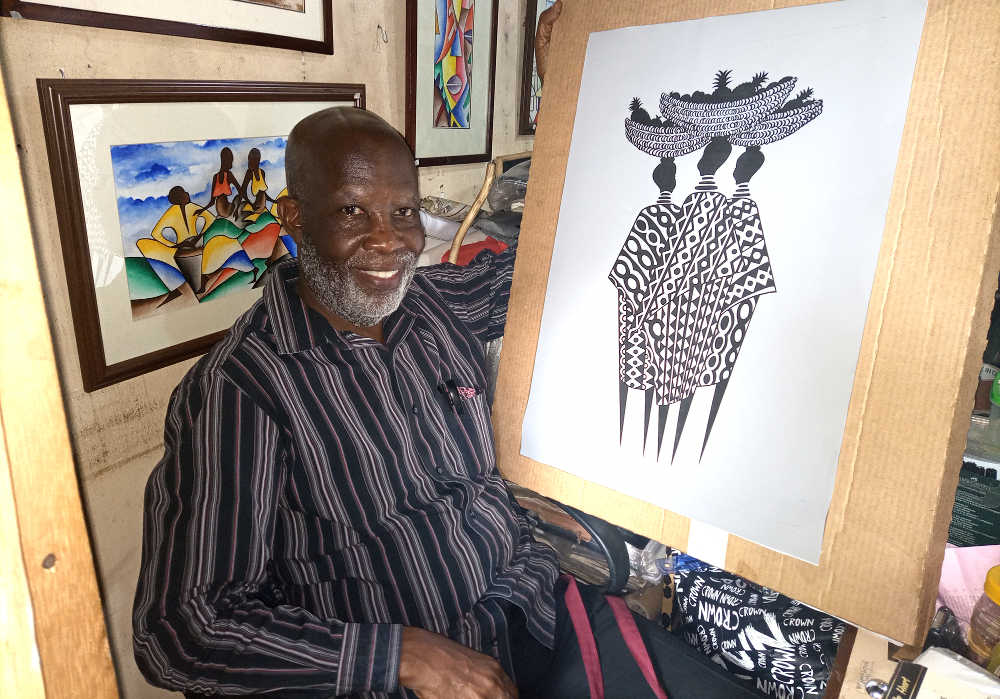
Nuwa Wamala Nnyanzi with one of his favourite pieces titled The Balancing Act
Nnyanzi’s works currently grace the living rooms of the rich and powerful in many parts of the world.
Most notable among the dignitaries who have been presented with his work, include the late Pope John Paul II, who received two of his pieces. One was a medal based on a batik titled Desperately Longing for Shelter, and was commissioned by United Nations Commission for Human Settlement – HABITAT headquartered in Nairobi Kenya, and the second one was a sculpture which Ronald Katumba did with inspiration from Nnyanzi’s earlier piece titled The Pentecost.
Nnyanzi’s works have also graced internationally circulated greeting cards, book covers for international organisations such as the World Health Organisation (WHO), UNICEF etc.
Beyond Talent
Nnyanzi’s impeccable talent and skill as a Batik painter is without dispute. But many agree that his runaway success is not to be attributed mostly to his brush strokes but rather to his personality attributes of professionalism, aggressive marketing, open-mindedness and sociability.
Blame it perhaps on his noble upbringing that brought him into regular contact with royals, or may be the military that instilled in him a high sense of discipline, Nnyanzi set out to change the image and perception that most people held of artists.
“Back in the day, artists were generally shabby,” I set out to change this perception. And in one of the early exhibitions I took part in South Africa and Kenya, many people were shocked to meet an artist who dressed in a suit with a bow-tie.”
By conducting himself in the most dignified way he could, Nnyanzi, not only earned personal respect, from high-class clients and exhibition goers, he also helped to change people’s perceptions about artists.
Appearances aside, Nnyanzi is a very organised person. At his Nnyanzi Art Studio located at the NACCAU Crafts Village of the Uganda National Theatre, the artist keeps a meticulous collection of all his previous art works, newspaper/magazine cuttings and pictures in which he featured.
For example, when I asked him to narrate for me how he got into the industry, he was not just able to give me a verbal record of what he has gone through, but he was also able to show hundreds of newspaper cuttings, and photographs of notable personalities who have inspired him.
Through achieves, meticulously put together in files and photographic albums both in print and online, Nnyanzi acknowledges, have helped him build a formidable brand that transcends borders.
Wondering how he acquired the impeccable art of organisation, I was alerted to the fact that Nnyanzi had served as a logistics personnel in the army as the in-charge of the Army Medical Stores. Both professions required a high sense of organisation and discipline which have since proved handy for the artist.
Some of his collections, though, mostly about his encounters with important persons such as the former American President Jimmy Carter, the King of the Zulu and memorable photographs in which his works were being presented by government officials, are the stuff of Uganda’s heritage that one might find difficult to locate.
Julius Lugaaya, a contemporary dance trainer and dramatist, acknowledges Nnyanzi’s dedication to his profession and dignified posture as attributes that have endeared many customers to his work.
“You see art has a lot to do with the personality. How you conduct yourself but also, how consistent and dedicated you are. All this helps to build a sense of reliability in a community. Nnyanzi decided that Art was going to be the thing he would live on and he has kept improving on it for many years,” says Lugaaya.
Jack Sserunkuuma, a cinematographer and documentary maker, complements Nnyanzi for his dedication to his job.
“He’s one of the the most committed Ugandan artists I’ve met. He chose to be a painter and that’s all he does,” Sserunkuuma adds: “But even with the fact that he is a master in his field, he has remained open-minded and welcomes criticism and advice about his pieces. When you find him painting, he often asks for your impression of the piece. And when you make an good observation which he believes enhances his piece, he does not hesitate to embrace it,”
Nnyanzi has also endeared other artists from other disciplines such as music, dance, because of his passion to unify and develop the industry into a respected sector that can contribute to Uganda’s development.
“When you visit his studio, you will be struck by the fact that he does not display only his pieces but also other types, by other artists. In fact, he never shies from making comments about other pieces, especially about packaging and finishing, because he knows they matter a lot in marketing.”
A revered figure across the arts sector
Aloysius Matovu Joy, one of the founder members of the drama group Bakayimbira says their group benefited immensely from his invaluable patronage and counsel, more so when they were about to break up.
“As Bakayimbira, we have great reverence for him for his dependability but also for his love of all other forms of art. That is why in one of our plays titled Akakomo, we named one character Nuwa Wamala Nnyanzi. I acted this part to portray a loyal, dependable person before his king.”
Aloysius, as he is fondly referred to, recollects that one day, the group had prepared a farewell show they staged in Nakibubo stadium. And that while they were on stage, a message came from the Kabaka of Buganda Ronald Muwenda Mutebi, was delivered by Nuwa Wamala Nnyanzi in which the Kabaka expressed concern that if Bakayimbira splintered, all that they had done strived for, would go to waste.
“The Kabaka’s wish was a command that we had to respect. We henceforth abandoned the plans for ceasing to perform and actually set about redoing all out previous plays and taking them to the population,
Aloysius adds that Nnyanzi’s passion for other forms of art, sometimes makes people identify him either as a manager or performing artist.
Moses Matovu of the legendary Afrigo band, has as much respect for Nnyanzi, perhaps as his namesake Aloysius.
“Despite his outstanding achievement and respect he wields as a well connected person, Nnyanzi has no airs around him. He has remained a down to earth person and one who wishes others to excel,” Matovu says of Nnyanzi.
“I remember in 1989, he did the artwork for one of our albums. But even then, he has constantly been one of our advisors as a group, but also as an industry,” adds Matovu known by peers as Papa Mois.
Asked what motivates him to embrace other art disciplines, Nnyanzi says that an artist, he has for long been dismayed by disrespect that artists commanded.
“I got involved in theater,music and other forms of art to render respect to art. But also I wish to share what I know with others.”
Comments




